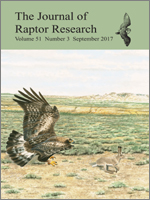Spatial demographic models can help guide monitoring and management activities targeting at-risk species, even in cases where baseline data are lacking. Here, we provide an example of how site-specific changes in land use and anthropogenic stressors can be incorporated into a spatial demographic model to investigate effects on population dynamics of Golden Eagles (Aquila chrysaetos). Our study focused on a population of Golden Eagles exposed to risks associated with rapid increases in renewable energy development in southern California, U.S.A. We developed a spatially explicit, individual-based simulation model that integrated empirical data on demography of Golden Eagles with spatial data on the arrangement of nesting habitats, prey resources, and planned renewable energy development sites. Our model permitted simulated eagles of different stage-classes to disperse, establish home ranges, acquire prey resources, prospect for breeding sites, and reproduce. The distribution of nesting habitats, prey resources, and threats within each individual's home range influenced movement, reproduction, and survival. We used our model to explore potential effects of alternative disturbance scenarios, and proposed conservation strategies, on the future distribution and abundance of Golden Eagles in the study region. Results from our simulations suggest that probable increases in mortality associated with renewable energy infrastructure (e.g., collisions with wind turbines and vehicles, electrocution on power poles) could have negative consequences for population trajectories, but that site-specific conservation actions could reduce the magnitude of negative effects. Our study demonstrates the use of a flexible and expandable modeling framework to incorporate spatially dependent processes when determining relative effects of proposed management options to Golden Eagles and their habitats.
How to translate text using browser tools
1 September 2017
Spatial Demographic Models to Inform Conservation Planning of Golden Eagles in Renewable Energy Landscapes
J. David Wiens

Journal of Raptor Research
Vol. 51 • No. 3
September 2017
Vol. 51 • No. 3
September 2017
Aquila chrysaetos
golden eagle
HexSim
population model
Renewable energy
source-sink dynamics




